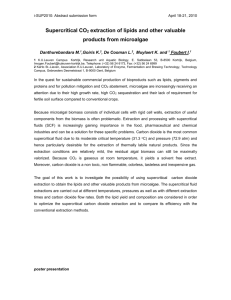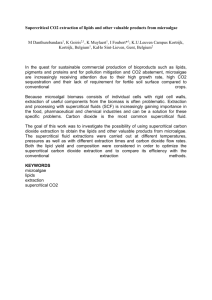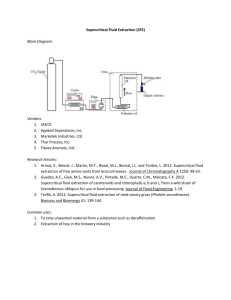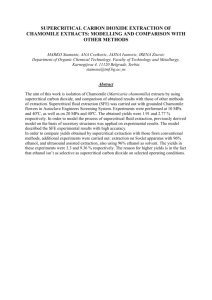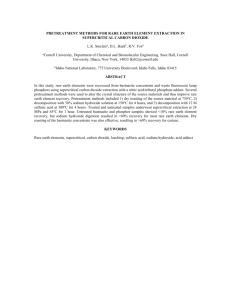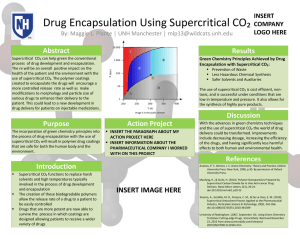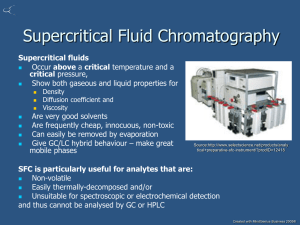Supercritical Fluid Solvents
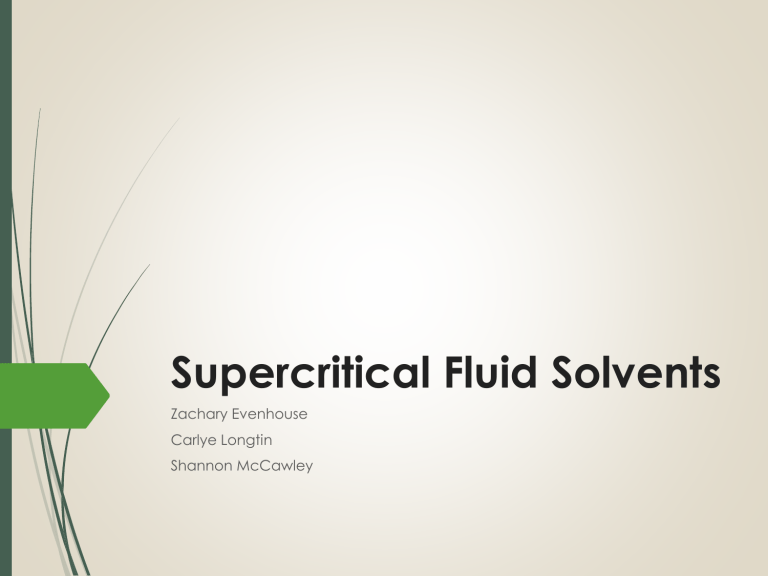
Supercritical Fluid Solvents
Zachary Evenhouse
Carlye Longtin
Shannon McCawley
Overview
What is a Supercritical Fluid?
Organic vs. Supercritical Fluids
Supercritical CO
2
Supercritical H
2
O
Conclusions
What are Supercritical Fluids?
Fluid at a temperature and pressure above the critical point
Liquid and gaseous states are indistinguishable
Evolution of a Supercritical Fluid
https://www.youtube.com/watch?v=GEr3NxsPT
OA
Organic Solvents
Traditionally organic solvents used
Industries:
Chemicals
Pharmaceuticals
Disposal of hazardous chemicals
Not environmentally friendly:
Toxic, flammable, pollutants
Supercritical Solvents
Environmentally Benign
Most common- CO
2
and H
2
O
Easily recycled
High selectivity
Tunability
Density, viscosity, diffusivity
What’s the Demand?
Demand stems from rising standards in the food and drug industries.
Extraction with SCF’s can often yield upwards of
90% pure product
Higher market values
Traditional extractions use toxic organic solvents like chloroform, dichloromethane, and ethyl acetate
scCO
2
is completely non-toxic and environmentally benign
scCO
2
is also 100% recoverable and recyclable
Supercritical CO
2
in Food Technology
Supercritical CO
2
is used in the extraction of oils, terpenes, aromatics, natural colorants, and recently cholesterol. Common extracts:
Beta-carotene (MW 536.87)
Morphine (MW 285.34)
Caffeine (MW 194.19)
Extraction Basic Principles
Solvent is pressurized
Sample introduced to extractor
Solvent flows through sample
Waste (solids) discarded
Flow-through captured
Solvent recycled
So why isn’t scCO
2
in mass use?
Only high-cost, low-volume reaction tanks exist
No financial incentive
Coffee and pharmaceutical industries are the only large markets
scCO
2
extraction is only useful on things with relatively low molecular weights
Not practical for use in industrial polymerization reactions
Co-solvents such as ethanol are sometimes necessary with higher MW compounds, which pose their own green issues
Supercritical Water (scW)
Temperature: 380-700 C
Pressure: 25-40 MPa
Potential use in several fields
Conversion & pretreatment of biomass
Supercritical oxidation
Organic and inorganic chemistry
Energy transfer medium (nuclear & geothermal)
Serious energy and corrosion challenges with its use
Conversion of Biomass
Main goal of SCW usage
SCW gasification of biomass
Used with wet biomass (>80% water weight)
Reaction occurs by forcing biomass slurry into supercritical state
Reaction creates syn-gas
At 400 ° C methane is main product
At 650 ° C hydrogen is main product
Gaseous products can be tuned by pressure and temperature
CO
2
dissolves in SCW, only hydrogen and methane collected gases
VERENA Plant in Karlsruhe, Germany
Biomass turned into slurry
Preheated to near critical conditions
Feed into nickel alloy reactor
Pressure and temperature increase,
SCWG occurs
H
2
& methane collected
Depressurized & CO
2 vented
scW Biomass Pretreatment
Lignin in plant material prevents enzymatic attack
Hydroxyaromatic polymer
Cellulose contains 10-25% ligning
Prevents fermentation into ethanol
scW pretreatment can be a solution
Hydrolyzes polymeric lignin with CO
2 as acid catalyst
Under mild scW conditions (400 C and
25 MPa)
After scW pretreatment the biomass had a much higher conversion to ethanol
Supercritical Water Oxidation
Used to destroy hazardous materials
Oxidation occurs in homogenous phase
Extremely fast
Near complete oxidation
Environmentally friendly/neutral products
Process is self-sustaining with respect to energy
Oxidation is exothermic
Heat generated is enough to meet energy requirements
Excess heat energy available for power generation
SCWO Process
Four primary steps
Feed preparation
Reaction
Salt separation
Heat recovery
Oxygen source
Air
Liquid O
2
Hydrogen Peroxide
Conclusions
Drawbacks
Potential extreme corrosion problems (scW)
Reactors made of exotic alloys
Energy intensive
Must be run as batch process
Cannot be used with high MW substances
Thermal degradation
scW cannot be used in pharmaceuticals
Conclusions cont.
Benefits
Unique properties
Oxidize hazardous chemicals (scW)
No catalyst for H
2
production from biomass (scW)
Little to no organic waste
Recyclable
Fast diffusion, low viscosity
Environmentally benign
Less separations
Large availability
Questions?
Sources
Background Info Sources:
• http://pubs.acs.org/doi/pdf/10.1021/es00104a716
• http://eprints.usm.my/8927/1/DEVELOPMENT_OF_IDENTIFICATION_TECHNIQUE_BY_FTIR-
PCA_FOR_SUPERCRITICALLY_EXTRACTED_METABOLITES_FROM_PARKIA_SPECIOSA_%28HASSK%29_SEEDS.pdf
• http://www3.nd.edu/~enviro/supercritical.html
scW Sources:
•
Data and processes: http://onlinelibrary.wiley.com.libezproxy.tamu.edu:2048/doi/10.1002/9781118310250.ch5/pdf
• Biomass pic: https://jeff-tester.cbe.cornell.edu/images/research/conversion.jpg
•
Oxidation pic: http://scfi.eu/wp-content/uploads/2010/05/d.jpg
• Lignin pic: http://www.lignoworks.ca/sites/default/files/what-is-lignin.png
scCO
2
Sources:
• Food Technology: http://fst.sagepub.com.lib-ezproxy.tamu.edu:2048/content/8/5/269.full.pdf+html
• Carotene Extraction: http://pubs.acs.org.lib-ezproxy.tamu.edu:2048/doi/pdf/10.1021/jf000311t
•
Decaffeinating Coffee: http://antoine.frostburg.edu/chem/senese/101/consumer/faq/decaffeinatingcoffee.shtml
•
Extraction Apparatus: http://pubs.rsc.org/en/content/articlehtml/2001/an/b008243k
